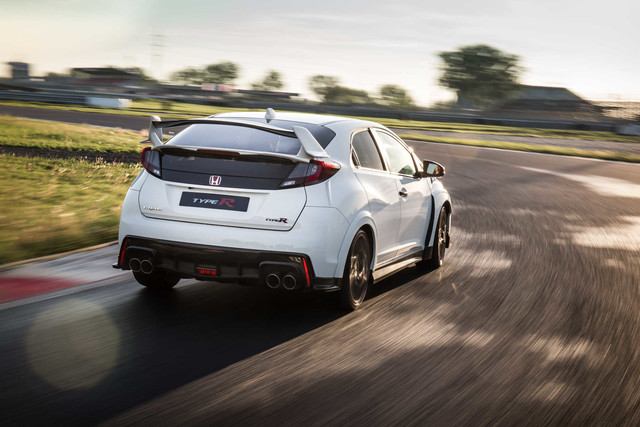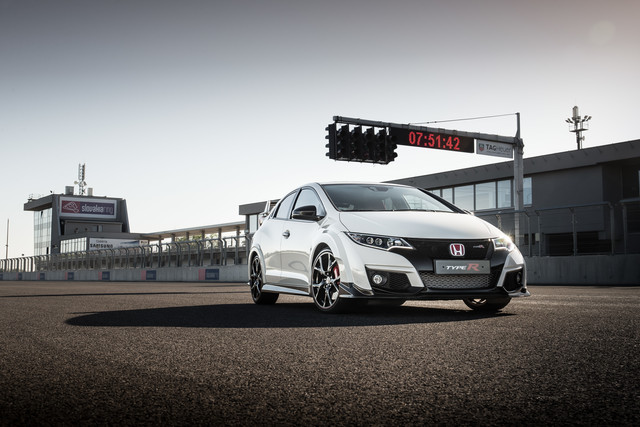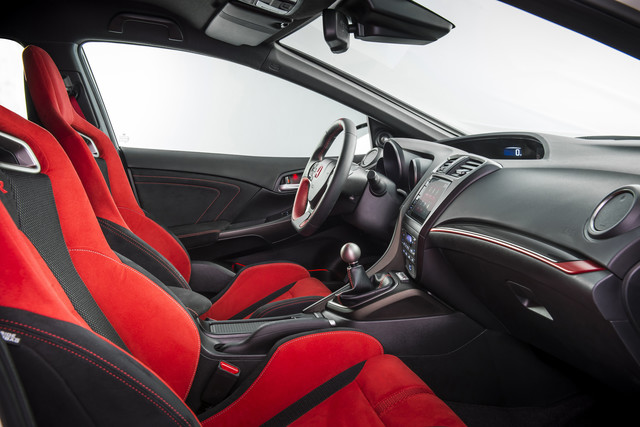It’s been five years since the last Honda Civic Type R was withdrawn from the UK’s automotive hot hatch menu – and I think it’s fair to say that car fans have been hungry for it. Although the Type R name has been found on the likes of the Integra and Accord, the Civic is undoubtedly its poster boy.
With anticipation building – helped by its conquering of the Nurburgring in just 7m 50.6s, the fastest time set by a two-wheel drive car, expectations are high. So why launch it now? Well, Honda claims that 2015 is the right time as sales for 300bhp plus hot hatches skyrocket.
One of the biggest talking points is the addition of a turbocharger, which comes installed along with the high-revving VTEC petrol engine technology famous from previous Type R’s. But as the Civic Type R has always been razor-sharp thanks to its naturally-aspirated, the new turbo could put off purists.
All of this technology can be yours for just £29,995. However, before you rush out and sign on the dotted line, we can’t ignore the fact that the four-wheel-drive Volkswagen Golf R and soon to launch Ford Focus RS are occupying the hallways of the same hot hatch segment.
 With the 2.0-litre VTEC turbo producing 306bhp, it delivers a 0-62mph time of 5.7 seconds – making this the most high performance engine in red ‘H’ history. It also has a top speed of 167mph. This engine is only available with a six-speed manual, something which Honda says is to “maintain as much man and machine connection as possible.” How much torque? Glad you asked, 400Nm at 2,500rpm.
With the 2.0-litre VTEC turbo producing 306bhp, it delivers a 0-62mph time of 5.7 seconds – making this the most high performance engine in red ‘H’ history. It also has a top speed of 167mph. This engine is only available with a six-speed manual, something which Honda says is to “maintain as much man and machine connection as possible.” How much torque? Glad you asked, 400Nm at 2,500rpm.
This isn’t just a standard Civic with a punchier turbocharged engine though. Honda has re-built the Civic from the ground-up and finely tuned and tweaked many technical aspects. Deep breath.
There is a new four point Adaptive Damper System (ADS), enabling the independent control of each wheel, allowing the car to adapt to multiple road surfaces in milliseconds and stay flat and stable when cornering on the track or during harsh braking and accelerating. At the front there is a new dual axle suspension and new balanced rigidity in the drive shafts allowing for reduced torque steer of 55 per cent, according to Honda engineers. The six-speed manual now has a shift of 40mm (shortest in its class) meaning quicker shifting. There’s increased body rigidity of 18 per cent due to added lightweight adhesive in key areas, high performance 350mm Brembo brake discs and specially designed super-sticky tyres.
Even if you are doing the school run or nipping to the shops, there is no avoiding that the Type R feels hotter than a normal hatch, due to the added weight and feedback at the steering wheel and slightly firmer suspension. You will only really feel the stiffness of the chassis however when you hit a bump or pothole.
 On the smooth open road of the motorway the Type R is extremely quiet and comfortable. You are unlikely to drive cross country in it, but if you did, comfort would not be a problem.
On the smooth open road of the motorway the Type R is extremely quiet and comfortable. You are unlikely to drive cross country in it, but if you did, comfort would not be a problem.
On to its track performance. Flat out, shifting up the gears in a straight line, the Type R is phenomenal, with its turbo kicking in in low down the revs and proving rather convincingly that Honda has made a wise choice with the new addition. The rev counter also tops out at 7,000rpm, meaning you can wring out each gear before having to switch up. Some may complain about the slightest bit of turbo lag at lower revs, but that is being very picky.
It’s when you start chucking it into corners that the new Type R really shines. The new ADS system allows for a planted entrance and exit in bends as the dampers account for its weight transfer through corners, ultimately giving it a solid, level stance, even at extreme speeds. The front-end behaves itself excellently and will latch onto an apex with ease thanks to the mechanical limited-slip differential helping prevent one front wheel from losing grip.
If you really want to enrage the beast then you can push the +R button – or as the Technical Communications guru at Honda called it, the “fighting mode button.” This sharpens up the throttle response, increases the damping force by 30 per cent, makes the arrival of torque more aggressive and takes the shackles off some of its steering assist features. The +R mode even lets you record your lap and sprint times on a small table behind the steering wheel. We also imagine that if you initiate +R mode on some of Britain’s bumpy roads, you will notice the added suspension stiffness and subsequent discomfort.
Aside to its tech spec under the metal, Honda has also done a lot of work in the aerodynamics department. Its body has a revised front splitter, rear wing and front fenders to reduce drag and increase downforce – something Honda is particularly proud of. There are also added air ducts underneath the wing mirrors and to the side of the front wheel arches in order to reduce the size of the vent at the front-end and yet retain engine cooling capabilities – again, reducing drag.
 Interior wise, quality is brilliant. There are bucket seats to keep you firmly in place, climate control, cruise control, Bluetooth and even a city brake active system – all as standard. Pay £2,300 more for the Type R GT trim level, which receives a Garmin sat-nav system, front and rear parking sensors and some additional red trimming on the front splitter and rear diffuser. The only slight niggle about the interior is that it can be tricky getting the right height for the steering wheel as the electronic speedometer is situated just above it.
Interior wise, quality is brilliant. There are bucket seats to keep you firmly in place, climate control, cruise control, Bluetooth and even a city brake active system – all as standard. Pay £2,300 more for the Type R GT trim level, which receives a Garmin sat-nav system, front and rear parking sensors and some additional red trimming on the front splitter and rear diffuser. The only slight niggle about the interior is that it can be tricky getting the right height for the steering wheel as the electronic speedometer is situated just above it.
For a two-wheel drive car, performance is incredible. But if you were to drive the Type R back to back with its rivals, their four-wheel-drive capabilities may just sway you when it comes to track prowess. But as a car that is aimed at being a race car for the road, it more than earns its stripes. The red badge is back with aplomb.



